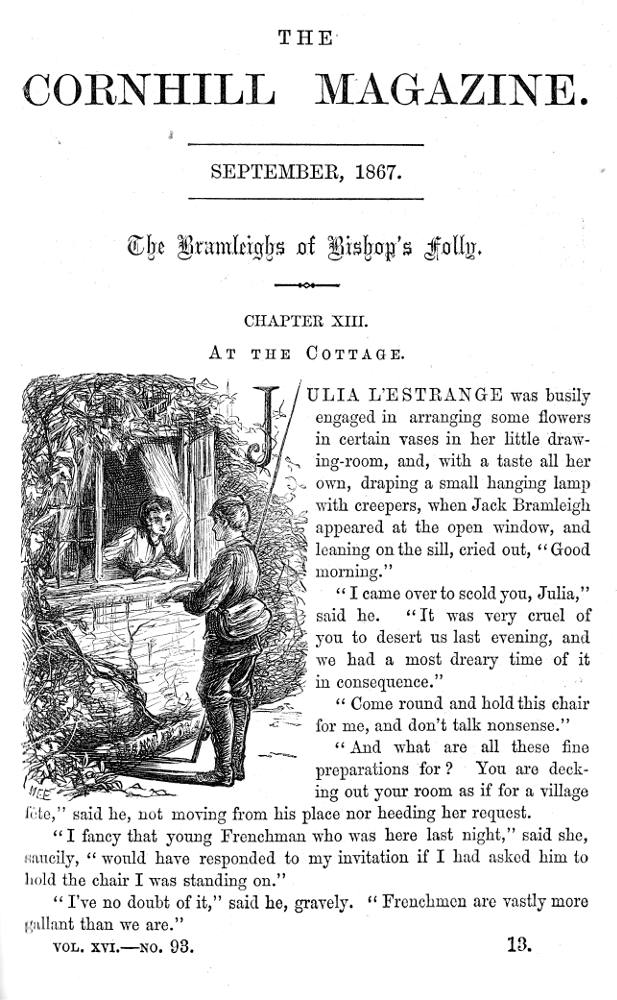

Initial-letter Vignette "J" (Julia L'Estrange chats with Jack Bramleigh at the window) (page 257) vertically-mounted, 7.5 cm high by 4.9 cm wide, signed "MEE." in the lower-left corners of the vignette and the main illustration. Mary Ellen Edwards, fourth thumbnail vignette illustration for Charles Lever's The Bramleighs of Bishop's Folly in the Cornhill Magazine (September 1867), Chapters XIII-XVI ("At the Cottage" through "Some Misunderstandings.") in Vol. 16: pages 256 through 278 (23 pages in instalment). The wood-engraver responsible for this illustration was Joseph Swain (1820-1909), noted for his engravings of Sir John Tenniel's cartoons in Punch. [Click on the image to enlarge it; mouse over links.]
This initial-letter vignette is based on the opening passage in Ch. 13:
Julia L'Estrange was busily engaged in arranging some flowers in certain vases in her little drawing-room, and, with a taste all her own, draping a small hanging lamp with creepers, when Jack Bramleigh appeared at the open window, and leaning on the sill, cried out, “Good-morning.”
“I came over to scold you, Julia,” said he. “It was very cruel of you to desert us last evening, and we had a most dreary time of it in consequence.”
“Come round and hold this chair for me, and don't talk nonsense.”
“And what are all these fine preparations for? You are decking out your room as if for a village fête,” said he, not moving from his place nor heeding her request.
“I fancy that young Frenchman who was here last night,” said she, saucily, “would have responded to my invitation if I had asked him to hold the chair I was standing on.”
“I've no doubt of it,” said he, gravely. “Frenchmen are vastly more gallant than we are.”
“Do you know, Jack,” said she again, “he is most amusing?” [257].
Comment: Introducing the Setting, Characters, Mood, and Tone
Thus, the opening vignette leads the reader immediately into Lever's opening scene for Chapter XIII, merging the illustration and the text through the initial letter "J" for "Julia," the attractive young woman at the cottage window surrounded by vines. The picture immediately establishes the playful tone, the romantic mood, the pastoral setting, and something about Jack as a sporting fisherman. Significantly, then, Edwards sets up expectations in the reader about the opening scene, even as (simultaneously) she gives readers an anticipatory set for the instalment's main illustration on the facing page (256), At the Cottage, which features Julia again, but this time with the older brother, George Bramleigh, rather than her fiance.
Although Jack, a half-pay, off-duty naval officer, is a vital part of Julia's romantic triangle, and is Lever's focus, Edwards makes him appear a mere boy, infatuated with the alluring curate's sister, in this fourth miniature. The passage realised underscores Jack's jealousy, and thus Edward's intention seems to be to underscore Jack's feelings in this passage.
Scanned images and text by Philip V. Allingham. [You may use these images without prior permission for any scholarly or educational purpose as long as you (1) credit the person who scanned them and (2) link your document to this URL in a web document or cite the Victorian Web in a print one.]
Bibliography
Lever, Charles. The Bramleighs of Bishop’s Folly. The Cornhill Magazine 15 (June, 1867): pp. 640-664, and (July-December 1867): 1-666. Rpt. London: Chapman & Hall, 1872. Illustrated by M. E. Edwards; engraved by Joseph Swain.
Stevenson, Lionel. "Chapter XVI: Exile on the Adriatic, 1867-1872." Dr. Quicksilver: The Life of Charles Lever. London: Chapman and Hall, 1939. Pp. 277-296.
Created 27 August 2023